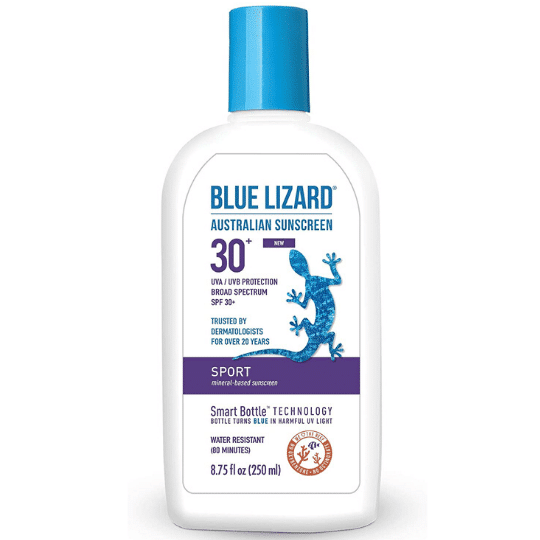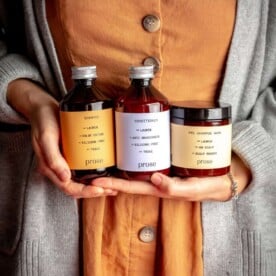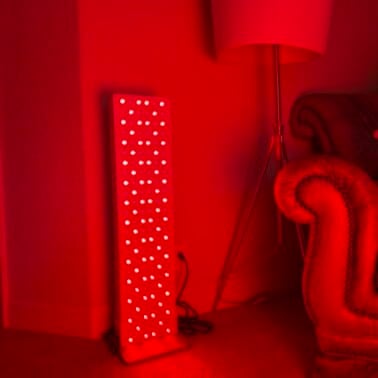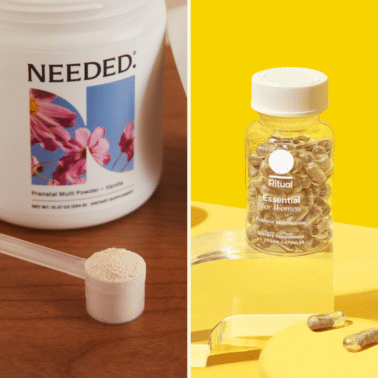The sun is out, and with this non-toxic sunscreen guide, you can rest assured that you can safely soak it up!

Table of Contents
- What is chemical sunscreen?
- How does mineral sunscreen work?
- Is mineral sunscreen reef-safe?
- What ingredients should you look for in a safer sunscreen?
- What can you do about the white residue left on your skin from mineral sunscreen?
- What’s the best way to wash off mineral sunscreen?
- What are the best brands of non-toxic sunscreen?
- More Favorite Wellness Articles
The sun is brightly shining, and I want to do all of the outdoorsy, sunshiney things! During this time of year especially, keeping my skin protected is a priority, and keeping it *safely* protected is a high priority. My VERY top priority though? Keeping not only my skin safely protected, but my family’s too. Knowing that my family is safe from the harmful effects of the sun AND toxic junk that is in conventional sunscreen gives this wife + mama huge peace of mind.
What is chemical sunscreen?
So, what’s the deal with chemical sunscreen and why should you make the safer swap here? First and foremost, most sunscreens that you’ll find on the shelf of your local drugstore are what’s known as chemical sunscreens. These sunscreens work like this: your skin absorbs the sunscreen (AND the chemicals that come with it), UV rays hit your skin and are also absorbed, and the sunscreen disperses the rays so they become less harmful to your body. These types of sunscreen have become more popular than mineral sunscreens over time because they blend into skin and wash off easily, but they do come with a few drawbacks.
Why should you consider avoiding chemical sunscreen?
- They are absorbed systemically. Because of their mechanism of action, chemical sunscreens are more likely to be absorbed systemically than mineral versions. Research shows that the active ingredients in these sunscreens do remain in the bloodstream after application(1).
- Many of the chemicals found in sunscreen are considered to be endocrine disruptors. Benzophones, camphor, and cinnamate derivatives have the potential to interfere with many systems in the body, including the endocrine, reproductive, and immune systems(2). Another troubling piece to this puzzle? Because of their still-developing, immature systems, endocrine disruptors are especially dangerous for our little ones.
- It may not be as protective as you think. Chances are, when you buy a new sunscreen you look for one with a high SPF rating. The higher the SPF the more protective it is, right? Well, not quite. It was previously thought that only the sun’s UVB rays, which largely cause sunburn, had negative effects on skin, but recent research has shown that exposure to lower-energy UVA rays can also cause damage to the skin over time, produce free radicals, and lead to skin cancer(3). Why is this important to know? Because in many cases, even the brands with the highest SPF don’t shield against UVA rays!
- It can be damaging to the environment. You may have heard of reef-safe sunscreen before, especially if you’ve ever been snorkeling or scuba diving around coral reefs. Ingredients like oxybenzone, octinoxate, and petrolatum can be harmful to sea life and lead to coral bleaching(4).
WHAT IF we told you that nothing has to be absorbed at all, though, and that the chemicals that make up traditional sunscreen aren’t actually necessary? It’s true. Read on to find out about our favorite natural sunscreen alternatives.
How does mineral sunscreen work?
Here’s how mineral sunscreen works: you apply the sunscreen, and it sits *on top of* your skin to create a physical barrier that reflects UV rays before they even reach your skin’s surface. That just makes good sense, right? No absorption of chemicals or toxic ingredients, no absorption of harmful UV rays, no absorption, PERIOD.
Is mineral sunscreen as effective as chemical sunscreen?
Good question! Bottom line, once you’ve lathered on sunscreen, you need to *know* that you’re being protected from the sun, right? Here’s the skinny on the efficacy of mineral sunscreen vs. chemical. Because this sunscreen creates a physical barrier between your skin and harmful UV rays, it’s able to actually block, reflect, and protect you from both UVB (think: sunburn rays) AND UVA rays. That’s more than chemical sunscreen can do – remember, chemical sunscreens absorb UV rays, so deeper penetrating UVA rays are actually able to enter your body and have potentially harmful effects. The only caveat? Mineral sunscreen may require more frequent application: at least every 2 hours and after a 40 minute (or longer) swim. That’s a small price to pay for more effective, safer sunscreen, though!

Is mineral sunscreen reef-safe?
YES. The two chemicals most responsible for reef damage are oxybenzone and octinoxate, both of which are found in chemical sunscreen. The damage that these chemicals are capable of is profound and includes (but is not limited to) coral bleaching, decreased fish fertility and reproduction, damaged immune and reproductive systems in sea urchins, and impaired growth and photosynthesis of green algae. Mineral sunscreen, on the other hand, is free from these gravely harmful chemicals and is considered reef-safe.
If you are in need of a reef-safe sunscreen, you should also look for a mineral formula that contains zinc oxide, not titanium dioxide, as it can also be harmful to the ocean.
What ingredients should you look for in a safer sunscreen?
The only active ingredients in the safest and most effective sunscreen should be Zinc Oxide and/or Titanium Dioxide, both of which are minerals and safe for our bodies and the environment.
What can you do about the white residue left on your skin from mineral sunscreen?
While physical sunscreen is certainly the better, safer option, it does have a reputation for leaving a chalky, white film on your skin. Our guess is that you don’t feel your most confident when you’ve got a visible layer of sunscreen covering you from head-to-toe, no matter how cute your bikini is! Here are a few ways to irradicate the white residue drawback: when applying, rub in your sunscreen in circular motions or use a sheer or tinted sunscreen.
What’s the best way to wash off mineral sunscreen?
In order to completely rid yourself of the layer of sunscreen that you liberally slathered on throughout your time in the sun, you’ll need a good exfoliant. This is actually a great way to wedge just a little bit of self-care into your day! When it comes to safer scrubs, Beautycounter’s Sugar Body Scrub tops the list because of its squeaky clean ingredients, high-performance, and invigorating scent! You can also use a body exfoliator like this one.
What are the best brands of non-toxic sunscreen?
We’ve done the research so that you don’t have to! From baby/kiddo sunscreen, to body lotion, to mist, to daily facial SPF, these sunscreens are the best of the best, the safest of the safest, and the ones that you can feel absolutely confident lathering on yourself and your family.
Beautycounter
Beautycounter is one of our favorite options for safer sunscreen because it is made of natural ingredients, provides adequate sun protection, is water resistant, and doesn’t leave a white cast on your skin.

- Countersun Sunscreen Lotion (EWG 2) – Physical SPF 30 formulated with non-nano zinc and California Poppy.
- Countersun Sunscreen Mist (EWG 3) – Everything we love about the original lotion but in an easy-to-use mist form!
- Countersun Daily Sheer Defense for Face (EWG 2) – This daily facial sunscreen provides protection against UVB and UVA rays and blue light, blends easily, and is formulated with antioxidants and moisturizing ingredients.
Badger
Badger is another popular brand for safer sunscreen products, we personally love it for keeping our kiddos protected from the sun!

- Clear Zinc Sunscreen Cream (EWG 1) – Badger’s sunscreen is formulated with clear zinc to prevent the usual white cast, plus it’s made with 98% organic ingredients.
- Active Baby Sunscreen Cream (EWG 1) – This formula is ideal for kids and babies!
Blue Lizard
Blue Lizard has a wide range of sunscreen options, including formulas for sensitive skin, reef-safe formulas, and sport formulas that will resist sweat.

- Sensitive Sunscreen (EWG 2) – This sunscreen is paraben and fragrance-free, and perfect for more sensitive skin types.
- Sport Mineral-Based Sunscreen (EWG 3) – This body lotion provides 80 minutes of water and sweat protection, making it a great choice for activities like hiking.
Supergoop
Supergoop offers up a sunscreen for everyone with over 40 different formulas available! If you just can’t get behind mineral formulas, Supergoop is one of few brands offering up clean chemical broad-spectrum sunscreen options that don’t contain harmful ingredients like oxybenzone.

- Unseen Sunscreen (EWG 2) – This invisible facial SPF is a great option for daily use.
- Play Antioxidant-Infused Body Mist (EWG 3) – Non-aerosol body mist that is sweat-resistant and reef-safe.
Drunk Elephant
Drunk Elephant is another great option for physical sunscreens that are great for daily use!

- Umbra Sheer Physical Daily Defense Lotion (EWG 2) – A sheer, physical sunscreen that delivers powerful broad-spectrum UVA/UVB protection and helps aid in the prevention of free radicals and oxidative damage.
- Umbra Tinte Physical Daily Defense (EWG 2) – All the same benefits of the original SPF, but tinted to give you a glowing finish!
We hope you found this guide to safer sunscreens helpful! If you have any favorite sunscreens that weren’t included here, we’d love to hear about them in the comments below.


















Love the Super Goop but the spray is sub par. Here is our Super Goop of choice and 2 other clean yet more expensive options that my family love and use daily:
My 13 yr old son:
For Face-Full Spectrum 360° Sun Silk Drops Organic Sunscreen SPF 30-$46
For body-PLAY Everyday Lotion SPF 50 5.5oz- $32
My oily weight lifting husband:
Body and Face-PLAY Everyday Lotion SPF 50 5.5oz- $32
My preference as a 40 yr old skin conscious active woman:
Face-Trish McEvoy BEAUTY BOOSTER® CREAM SPF 30- $92
Body and Face-PLAY Everyday Lotion SPF 50 5.5oz- $32
Thanks for sharing this with us, Brooke!
Thank you so much for putting other options here than just BeautyCounter! While I love their products, my son had a terrible skin reaction to their sunscreen, so we’ve been looking for other safe alternatives! This is so helpful!
So glad you find it helpful, Kate!!
Thanks team Fed and Fit for this great article!
You’re so welcome, Erin!!